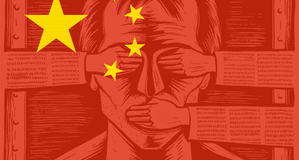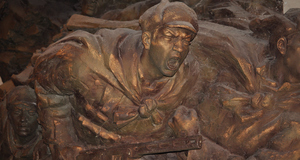From Interstate - Journal of International Affairs VOL. 1999/2000 NO. 1A New Red Peril? An Analysis of China's Role in the 21st Century
By
Interstate - Journal of International Affairs 2000, Vol. 1999/2000 No. 1 | pg. 1/1
KEYWORDS:
In order to understand why China has been recognised as a potential 21st Century superpower, it is necessary to understand what the term “superpower” encompasses. Domination of the world economy is arguably a key factor, as is internal stability and unity, and military power. It is essential that those who study international relations investigate these three prerequisites separately in an attempt to assess China’s potential to become the dominant player in the next century. It is the incredible growth of China’s economy that has brought it to the attention of Western observers. The moves away from a closed economy to a more export- driven, free market economy were initiated before Mao Zedong’s death in 1976. However, real momentum for greater liberalisation only came after then, when Deng Xiaoping, who gained leadership two years later, was able to introduce a programme of reformation. The results of reform speak for themselves. In 1978, China’s share of world trade was half a percent. Within only years of entering the world economy, China’s economy has overtaken Japan’s and is predicted to be greater than the US’s within 20 years. It has witnessed real GDP growth rates of 8% and above since reforms were started, and during the period between 1990 and 1996 growth averaged 12.6%. Economists and the Chinese reformers have identified their huge dearth of potential in natural resources and man-power. Consequently, foreign investment is now flowing into China. Although GDP is still relatively small, $906 in 1998, using the Purchase Power Parity rate, this figure is significantly higher. But while China’s economic dynamism is its greatest strength, it is arguably where the biggest doubts about China’s future can be found.China’s modernisation programme has largely been viewed as a success. Unlike Russia, and the ex-Soviet states of Eastern Europe, China did not follow the “Big Bang” thesis of reform at all levels at the same time. Instead it initiated small reforms, and those whose benefits would be felt first. At a very basic level, to make straight-line predictions with regards to any country’s economic growth grossly simplifies analysis. It also masks the real problems that such rapid change can bring. China’s rate of inflation is high, and the state cannot effectively control it. The rate varies substantially and hits the poorest provinces of the centre the worst where it is as high as 50%. Within 20 years China has barely had the time to prepare itself for such changes, and thus the infrastructure is not equipped to cope. Communication and transportation networks are not always adequate, leading to bottlenecks in the system, which cause the system to breakdown. This problem is exacerbated further by inter-province disputes. Inter-province tensions are just one of the problems that stand in the way of China’s political stability, which leads onto the second debate, about whether or not China is politically stable enough to play a greater international role. The latter half of the 20th Century has witnessed the integration of more and more ex-socialist regimes into the global economy; but an easy way to tackle the transition has not been found. Mass overhaul of the economy cannot be achieved without serious political ramifications, and China has been no exception. For the first time in living memory, criminal activity in China is rife. Formerly, the Work Unit, or the Street Committee would have been a powerful deterrent (it is of interest to note that the crime rates have been growing faster in the provinces where reforms have been most successful.). The PRC has also been forced to let the outside world in, and in a country where ownership of a computer used to be prohibited, the state is now being challenged by the influx of information and news through the world media. The state simply does not have the resources to try and tackle this or the potential problems this has created. Most notable have been the challenges to the State and Party itself. The collapse of the Soviet bloc has had repercussions universally, and some would argue that the very ideology that underpins China has been undermined. However, the PRC had lost much of its legitimacy by itself, and consequently by the time of Mao Zedong’s death the population was already suspicious and cynical. They had witnessed constant ideological changes and decades of indiscriminate persecutions. The Great Leap Forward, 1957-1965, had resulted in a mass famine that killed 20 million people, and then the monstrous atrocities committed in the name of Communism against “Capitalist Roaders” during the Cultural Revolution, left a lasting impression. Open discontent, however was limited, and it was not until 1986, that overt pro-democracy movements started to make their presence known in over 12 cities including Shanghai, laying the foundations of the protest that took place in Tiannamen Square after Hu Yaobang’s death 3 years later. The massacre of between 2,000 and 7,000 students by the PLA on the 3rd June both highlighted and reinforced the alienation and distrust between the people and the Party. Externally, it isolated China and reopened debates about human rights. It exposed too vividly how fragile the foundations that hold the country together are. Furthermore, many scholars recognise the potential for fragmentation of the Chinese state, as growing degrees of regionalism threaten the status quo. These problems can be divided into three broad categories: those that are inherent in the vast geographical area that is China; those inherited from the Mao regime; and those created during the process of reform. The task of ruling such a large populous country as a single sovereign state has created problems before, and has the potential to do more damage. Lucian Pye noted that rather than being “another nation state, among nations, China is a civilisation pretending to be a state”. Although technically China’s 1.2bn population is 94% Chinese Han, this masks the linguistic and ethnic divides. The country is home to large populations of Taoists, Muslims, Christian and variations of Buddhism. Western attention has been brought mostly to the continued suppression of Tibetan Buddhists. But there are problems elsewhere, especially in the Northwest provinces, which have already witnessed uprisings against the Chinese state by their predominantly Muslim communities. Other problems are the legacy of the political structure established by Mao and the CCP. After the victories of 1949, the CCP inherited a system of provinces, within which the framework of government was replicated. In theory, these provinces hold equal status, and problems can only be mediated by the centre. In practice, this has led to border disputes and on some occasions minor civil war. There has also long been a divide between the urban and rural populations. The processes of reform have exacerbated all of these problems. The fruits of economic reform fell largely to the southern coastal provinces, who are now arguably reluctant to support the poorer rural provinces. There are substantial differences in the resources available in different regions, and now that they are being granted higher degrees of autonomy, trade disputes and inter-province tension is growing. Thus, theorists have questioned the unity and stability of a country which is home to so many disparate interests and is in danger of fragmentation or full-scale civil war. There are, however, two paradoxes to be noted when contemplating the prospect of a disintegrating PRC. The first is that the PRC can be seen as actually broadening its geographical control: this includes the reintegration of Hong Kong (formerly part of Greater China), claims on the South China Sea, and continued hold onto territories such as Mongolia and Tibet. The other factor is the rise in Chinese nationalism, a phenomenon that has been paralleled in other Asia Pacific countries. Finally, attention must be turned to China’s military potential. As well as controlling the world’s largest standing army, the Chinese military have consistently increased their budget during the 1990s, though by how much is a point of contention among scholars. Certainly China has massive military might; its arms industry is self-dependent and capable of producing armaments of comparable quality to Western manufacturers; it has the largest ground forces on the surface of the globe (PLA); the PLN (People’s Liberation Navy) has acquired power-projection capabilities from the former-Soviet Union; and following its acquisition of nuclear weaponry in 1964, the PRC has now successfully launched a SLBM type submarine. I believe that China certainly does have aggressive aspirations; in 1988 they fought the Vietnamese for control of certain strategic islands; in 1992 the National People’s Congress laid claim to the whole of the South China Sea; in 1995 they occupied Mischief reef off the coast of the Philippines; and most recently held military exercises in 1996 off the coast of Taiwan, while engaging in missile testing in the Taiwan Strait. To an Asian observer these incidents are indicative of an emergent ‘Greater China’, a nation which was willing to effectively blockade Taiwan in 1996, causing two United States carrier groups to be deployed in the waters off Taiwan. Militarily, the Chinese have backed up these moves by test firing their first mobile intercontinental ballistic missile (the Dongfeng-31), deploying anti-missile defenses around major cities, increasing domestic acquisitions for the PLA, purchasing Kilo-class attack submarines and Yukan amphibious attack craft, as well as expanding its air-forces’ range and firepower. At the moment, its nuclear forces exist at minimal deterrence levels, mostly configured for retaliatory action rather than a ‘first-strike’ option (now that it has a submarine launch capability, it presumably has strategic weaponry also); the PLA is massive but poorly trained and equipped, without mechanisation; the PLN still has significant reliance upon small vessels and diesel submarines; and China’s air force is at least two or three generations behind those of its developed neighbours despite being third largest in the world. It is worth questioning, however, whether military strength is still a prerequisite of power on the global stage. Arguably, it is now economic strength that dictates super power status. For much of the Cold War, and indeed in the post-Cold War world, a superpower was also defined by another factor, that of space capability. The United States and the Soviet Union could vie to land on the moon first because they were superpowers, they built satellites and orbital bodies, and planned on creating manned stations. China officially joined the space race by launching a craft designed to take astronauts into low orbit; the Shenzou or ‘magic vessel’ means that China is now the third nation in history to launch a vehicle capable of lifting human beings into space. Although China remains a poverty-stricken agricultural nation, where the average income is less than $100 and urban unemployment is rising, it has strong ambitions to regain its former glory and become a world power. China has taken no part in the construction program of the International Space Station, but, even Japan which is fully involved in the ISS, has its own satellite and rocket programs. Being capable of putting a man in space is seemingly a select club, and it is a club which the Chinese, ahead of the European Space Agency or the Canadian Space Agency, is trying to join. It is a symbol of superpower status to have the capability of space placement, but it does need large economic and construction potential; China patently does not have that, just as the USSR did not have the relative ability to compete with the Strategic Defence Initiative. Despite China’s dynamic economic growth, it is a country that has neither the national will nor the overall capacity to become a global superpower in the 21st century. Instead it is beginning a process of internal consolidation. The end of the cold war and the progressive decline of the US’s economy have inevitably led to debates about which countries and conflicts will set the agenda of world politics in the next century. The focus on China is arguably part of a larger civilisation debate, representing the potential for a challenge to western cultural hegemony in the 21st Century. Suggested Reading from Inquiries Journal
Inquiries Journal provides undergraduate and graduate students around the world a platform for the wide dissemination of academic work over a range of core disciplines. Representing the work of students from hundreds of institutions around the globe, Inquiries Journal's large database of academic articles is completely free. Learn more | Blog | Submit Latest in International Affairs |



















